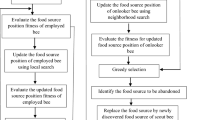Abstract
Artificial bee colony optimization is applied to determine the optimal hourly schedule of power generation in a hydrothermal system. Artificial bee colony optimization is a swarm-based algorithm inspired by the food foraging behavior of honey bees. The algorithm is tested on a multi-reservoir cascaded hydroelectric system having prohibited operating zones and thermal units with valve point loading. The ramp-rate limits of thermal generators are taken into consideration. The transmission losses are also accounted for through the use of loss coefficients. The algorithm is tested on two hydrothermal multi-reservoir cascaded hydroelectric test systems. The results of the proposed approach are compared with those of differential evolution, evolutionary programming and particle swarm optimization. From numerical results, it is found that the proposed artificial bee colony optimization based approach is able to provide better solution.





Similar content being viewed by others
Abbreviations
- a si , b si , c si , d si , e si :
-
Cost curve coefficients of ith thermal unit
- C 1j , C 2j , C 3j , C 4j , C 5j , C 6j :
-
Power generation coefficients of jth hydro unit
- I hjt :
-
Inflow rate of jth reservoir at time t
- k :
-
Index of prohibited zones of a hydro unit
- N s :
-
Number of thermal generating units
- N h :
-
Number of hydro generating units
- n j :
-
Number of prohibited zones for hydro unit j
- P sit :
-
Output power of ith thermal unit at time t
- P min si , P max si :
-
Lower and upper generation limits for ith thermal unit
- P Dt :
-
Load demand at time t
- P Lt :
-
Transmission loss at time t
- P hjt :
-
Output power of jth hydro unit at time t
- P min hj , P max hj :
-
Lower and upper generation limits for jth hydro unit
- Q hjt :
-
Water discharge rate of jth reservoir at time t
- Q min hj , Q max hj :
-
Minimum and maximum water discharge rate of jth reservoir
- Q L hj,k , Q U hj,k :
-
Lower and upper bounds of kth prohibited zones of hydro unit j
- R uj :
-
Number of upstream units directly above jth hydro plant
- S hjt :
-
Spillage of jth reservoir at time t
- t, T :
-
Time index and scheduling period
- UR i , DR i :
-
Ramp-up and ramp-down rate limits of the ith thermal unit
- V hjt :
-
Storage volume of jth reservoir at time t
- V min hj , V max hj :
-
Minimum and maximum storage volume of jth reservoir
- τ lj :
-
Water transport delay from reservoir l to j
References
M.V.F. Pereira, L.M.V.G. Pinto, A decomposition approach to the economic dispatch of the hydrothermal systems. IEEE Trans. PAS 101(10), 3851–3860 (1982)
Q. Xia, N. Xiang, S. Wang, B. Zhang, M. Huang, Optimal daily scheduling of Cascaded plants using a new algorithm of non-linear minimum cost network flow. IEEE Trans. PWRS 3(3), 929–935 (1988)
S. Chang, C. Chen, I. Fong, P.B. Luh, Hydroelectric generation scheduling with an effective differential programming. IEEE Trans. PWRS 5(3), 737–743 (1990)
A.A.F.M. Carneiro, S. Soares, P.S. Bond, A large scale of an optimal deterministic hydrothermal scheduling algorithm. IEEE Trans. PWRS 5(1), 204–211 (1990)
M.S. Salam, K.M. Nor, A.R. Hamdam, Hydrothermal scheduling based Lagrangian relaxation approach to hydrothermal coordination. IEEE Trans. PWRS. 13(1), 226–235 (1998)
W.S. Sifuentes, A. Vargas, Hydrothermal scheduling using benders decomposition: accelerating techniques. IEEE Trans. PWRS 22(3), 1351–1359 (2007)
K.P. Wong, Y.W. Wong, Short-term hydrothermal scheduling part 1: simulated annealing approach. IEE Proc. Gener. Transm. Distrib. 141(5), 497–501 (1994)
P.C. Yang, H.T. Yang, C.L. Huang, Scheduling short-term hydrothermal generation using evolutionary Programming techniques. IEE Proc. Gener. Transm. Distrib. 143(4), 371–376 (1996)
S.O. Orero, M.R. Irving, A genetic algorithm modeling framework and solution technique for short term optimal hydrothermal scheduling. IEEE Trans. PWRS 13(2), 501–518 (1998)
E. Gil, J. Bustos, H. Rudnick, Short-term hydrothermal generation scheduling model using a genetic algorithm. IEEE Trans. PWRS 18(4), 1256–1264 (2003)
N. Sinha, R. Chakrabarti, P.K. Chattopadhyay, Fast evolutionary programming techniques for short-term hydrothermal scheduling. IEEE Trans. PWRS 18(1), 214–220 (2003)
L. Lakshminarasimman, S. Subramanian, Short-term scheduling of hydrothermal power system with cascaded reservoirs by using modified differential evolution. IEE Proc. Gener. Transm. Distrib. 153(6), 693–700 (2006)
P.K. Hota, A.K. Barisal, R. Chakrabarti, An improved PSO technique for short-term optimal hydrothermal scheduling. Elect. Power Syst. Res. 79(7), 1047–1053 (2009)
R.K. Swain, A.K. Barisal, P.K. Hota, R. Chakrabarti, Short-term hydrothermal scheduling using clonal selection algorithm. Int. J. Electr. Power Energy Syst. 33, 647–656 (2011)
P.K. Roy, Teaching learning based optimization for short-term hydrothermal scheduling problem considering valve point effect and prohibited discharge constraint. Int. J. Electr. Power Energ. Syst. 53, 10–19 (2013)
E. Bonabeau, M. Dorigo, G. Theraulaz, Swarm Intelligence: From Natural to Artificial Systems (Oxford University Press, New York, 1999)
R. Eberhart, Y. Shi, J. Kennedy, Swarm Intelligence (Morgan Kaufmann, San Francisco, 2001)
S. Camazine, J. Deneubourg, N.R. Franks, J. Sneyd, G. Theraula, E. Bonabeau, Self-Organization in Biological Systems (Princeton University Press, Princeton, 2003)
D. Karaboga, An idea based on honey bee swarm for numerical optimization, Technical Report-Tr06t, Erciyes University, Engineering faculty, Computer Engineering Department, Turkey, 2005
Author information
Authors and Affiliations
Corresponding author
Appendix
Appendix
Transmission loss coefficients are given below:
Rights and permissions
About this article
Cite this article
Basu, M. Artificial Bee Colony Optimization for Short-Term Hydrothermal Scheduling. J. Inst. Eng. India Ser. B 95, 319–328 (2014). https://doi.org/10.1007/s40031-014-0119-7
Received:
Accepted:
Published:
Issue Date:
DOI: https://doi.org/10.1007/s40031-014-0119-7




